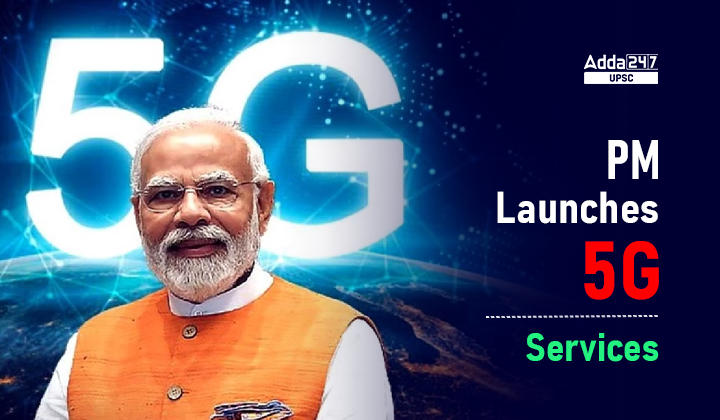Table of Contents
PM Launches 5G Services- Relevance for UPSC Exam
- GS Paper 2: Governance, Administration and Challenges
- Government policies and interventions for development in various sectors and issues arising out of their design and implementation.
PM Launches 5G Services in News
- Recently, the Prime Minister, Shri Narendra Modi launched 5G services in Pragati Maidan, New Delhi, ushering in a new technological era.
- He also inaugurated the sixth edition of the India Mobile Congress and also witnessed the IMC Exhibition that was put on the occasion.
5G Services- Demonstration by Major Telecom Operators
The three major telecom operators of the country demonstrated one use case each in front of the Prime Minister to show the potential of 5G technology in India.
- Reliance Jio: It connected a teacher from a school in Mumbai, with students in three different locations in Maharashtra, Gujarat and Odisha.
- This demonstrated how 5G will facilitate education by bringing teachers closer to students, obliviating the physical distance between them.
- It also demonstrated the power of Augmented Reality (AR) on screen and how that is being used to teach children across the country, remotely, without the need for an AR device.
- Vodafone Idea: Its test case demonstrated the safety of workers in an under-construction tunnel of Delhi Metro through the creation of a Digital Twin of the tunnel on the dias.
- Digital Twin will help give safety alerts to workers in real time from a remote location.
- Airtel demo: students from Dankaur, Uttar Pradesh witnessed a lively and immersive education experience to learn about the solar system with the help of Virtual reality and Augmented reality.
5G Services- Four Pillars of Digital India
Digital India focuses on 4 Pillars, in four directions at once. The four pillars are as follows-
- Price of the Device: The low cost of devices can only be achieved through Aatmnirbharta. The mobile manufacturing units have now gone up to 200.
- From exporting zero mobile phones in 2014, today India has become a mobile phone exporting country worth thousands of crores.
- All these efforts have had an impact on the cost of the device. The government is further working on ensuring more features at a lower cost.
- Digital Connectivity: From less than 100 panchayats in 2014 now 1.7 lakh panchayats are connected by optical fiber.
- Government is working on the goal of Internet for all.
- Cost of Data: the industry was given a slew of incentives and technologies like 4G received policy support. This brought down the price of data and a data revolution was ushered in the country.
- Idea of ‘Digital First’: India went ahead and made the way for digital payments easier. The government itself promoted citizen-centric delivery service through the app.
Importance of 5G Services
- 5G technology will offer a wide range of benefits to the common people. It will help in providing seamless coverage, high data rate, low latency, and highly reliable communications.
- Also, It will increase energy efficiency, spectrum efficiency and network efficiency.
- 5G technology will help in connecting billions of Internet of Things devices, will allow higher quality video services with mobility at high speed, and delivery of critical services such as telesurgery and autonomous cars among others.
- 5G will help in real-time monitoring of disasters, precision agriculture, and minimising the role of humans in dangerous industrial operations such as in deep mines, offshore activities etc.
- Unlike existing mobile communication networks, 5G networks will allow tailoring of requirements for each of these different use cases within the same network.
What is 5G technology?
- 5G or fifth generation is the latest upgrade in the long-term evolution (LTE) mobile broadband networks. It works in 3 bands, namely low, mid and high frequency spectrum — all of which have their own uses as well as limitations.
- The maximum speed in the low band spectrum is 100mbps. So, while it can be used and installed for cell phone users who may not have specific demands for very high-speed internet, the low band spectrum may not be optimal for specialised needs of the industry.
- The mid-band spectrum offers higher speeds compared to the low band. It, however, has limitations in terms of coverage area and penetration of signals.
- The high-band spectrum offers the highest speed of all the three bands, but has extremely limited coverage and signal penetration strength.
Cabinet approves Auction of IMT/5G Spectrum




 TSPSC Group 1 Question Paper 2024, Downl...
TSPSC Group 1 Question Paper 2024, Downl...
 TSPSC Group 1 Answer key 2024 Out, Downl...
TSPSC Group 1 Answer key 2024 Out, Downl...
 UPSC Prelims 2024 Question Paper, Downlo...
UPSC Prelims 2024 Question Paper, Downlo...
